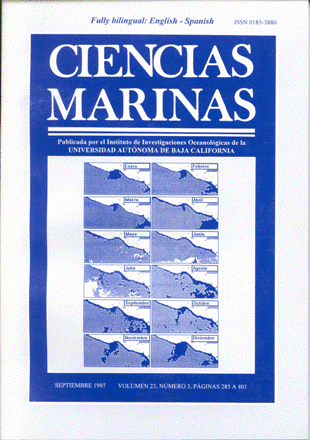Mixing in the region of the midrift islands of the Gulf of California: effect on surface pCO2
Main Article Content
Abstract
Surface seawater carbon dioxide partial pressure (pCO2) and the CO2 flux through the air-sea interface in the region of the midrift islands of the Gulf of California were estimated. We used surface temperature (ºC), salinity and pH data collected during summer 1990, and we assumed a constant specific alkalinity value. Mixing by tide-related phenomena is particularly strong in this region of the gulf, and our objective was to compare the effect of post-spring tides with that of post-neap tides. Carbon dioxide was either near equilibrium or flowing from the water to the atmosphere, even with post-neap tides. Surface cooling, and larger pCO2 and CO2 flux were detected with post-spring tides. relative to post-neap tides (<4 mM m–2 d–1 with post-neap tides. up to 23 mM m–2 d–1 with post-spring tides). There is a fortnightly modulation of the CO2 system in the surface waters of this region due to the spring-neap tide sequence. Tidal mixing is a “physical pump” that carries CO2 efficiently from intermediate depths (500 m) to the atmosphere in this region of the gulf.
Downloads
Article Details
This is an open access article distributed under a Creative Commons Attribution 4.0 License, which allows you to share and adapt the work, as long as you give appropriate credit to the original author(s) and the source, provide a link to the Creative Commons license, and indicate if changes were made. Figures, tables and other elements in the article are included in the article’s CC BY 4.0 license, unless otherwise indicated. The journal title is protected by copyrights and not subject to this license. Full license deed can be viewed here.

